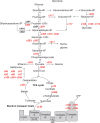Hormone regulation of rhizome development in tall fescue (Festuca arundinacea) associated with proteomic changes controlling respiratory and amino acid metabolism
- PMID: 27443301
- PMCID: PMC4998981
- DOI: 10.1093/aob/mcw120
Hormone regulation of rhizome development in tall fescue (Festuca arundinacea) associated with proteomic changes controlling respiratory and amino acid metabolism
Abstract
Background and aims: Rhizomes are underground stems with meristematic tissues capable of generating shoots and roots. However, mechanisms controlling rhizome formation and growth are yet to be completely understood. The objectives of this study were to investigate whether rhizome development could be regulated by cytokinins (CKs) and gibberellic acids (GAs), and determine underlying mechanisms of regulation of rhizome formation and growth of tall fescue (Festuca arundinacea) by a CK or GA through proteomic and transcript analysis.
Methods: A rhizomatous genotype of tall fescue ('BR') plants were treated with 6-benzylaminopurine (BAP, a synthetic cytokinin) or GA3 in hydroponic culture in growth chambers. Furthermore, comparative proteomic analysis of two-dimensional electrophoresis and mass spectrometry were performed to investigate proteins and associated metabolic pathways imparting increased rhizome number by BAP and rhizome elongation by GA3 KEY RESULTS: BAP stimulated rhizome formation while GA3 promoted rhizome elongation. Proteomic analysis identified 76 differentially expressed proteins (DEPs) due to BAP treatment and 37 DEPs due to GA3 treatment. Cytokinin-related genes and cell division-related genes were upregulated in the rhizome node by BAP and gibberellin-related and cell growth-related genes in the rhizome by GA3 CONCLUSIONS: Most of the BAP- or GA-responsive DEPs were involved in respiratory metabolism and amino acid metabolism. Transcription analysis demonstrated that genes involved in hormone metabolism, signalling pathways, cell division and cell-wall loosening were upregulated by BAP or GA3 The CK and GA promoted rhizome formation and growth, respectively, by activating metabolic pathways that supply energy and amino acids to support cell division and expansion during rhizome initiation and elongation in tall fescue.
Keywords: Rhizome; hormone; protein; tall fescue; transcription.
© The Author 2016. Published by Oxford University Press on behalf of the Annals of Botany Company. All rights reserved. For Permissions, please email: journals.permissions@oup.com.
Figures











Similar articles
-
Differential regulatory pathways associated with drought-inhibition and post-drought recuperation of rhizome development in perennial grass.Ann Bot. 2020 Aug 13;126(3):481-497. doi: 10.1093/aob/mcaa099. Ann Bot. 2020. PMID: 32445476 Free PMC article.
-
Gibberellin-Stimulation of Rhizome Elongation and Differential GA-Responsive Proteomic Changes in Two Grass Species.Front Plant Sci. 2016 Jun 23;7:905. doi: 10.3389/fpls.2016.00905. eCollection 2016. Front Plant Sci. 2016. PMID: 27446135 Free PMC article.
-
Gibberellic acid inhibition of tillering in tall fescue involving crosstalks with cytokinins and transcriptional regulation of genes controlling axillary bud outgrowth.Plant Sci. 2019 Oct;287:110168. doi: 10.1016/j.plantsci.2019.110168. Epub 2019 Jun 12. Plant Sci. 2019. PMID: 31481214
-
Gibberellin-Regulation and Genetic Variations in Leaf Elongation for Tall Fescue in Association with Differential Gene Expression Controlling Cell Expansion.Sci Rep. 2016 Jul 26;6:30258. doi: 10.1038/srep30258. Sci Rep. 2016. PMID: 27457585 Free PMC article.
-
Tall or short? Slender or thick? A plant strategy for regulating elongation growth of roots by low concentrations of gibberellin.Ann Bot. 2012 Jul;110(2):373-81. doi: 10.1093/aob/mcs049. Epub 2012 Mar 21. Ann Bot. 2012. PMID: 22437663 Free PMC article. Review.
Cited by
-
Physiological and iTRAQ-based proteomic analyses reveal the function of exogenous γ-aminobutyric acid (GABA) in improving tea plant (Camellia sinensis L.) tolerance at cold temperature.BMC Plant Biol. 2019 Jan 30;19(1):43. doi: 10.1186/s12870-019-1646-9. BMC Plant Biol. 2019. PMID: 30700249 Free PMC article.
-
Cytokinin and Metabolites Affect Rhizome Growth and Development in Kentucky Bluegrass (Poa pratensis).Biology (Basel). 2023 Aug 11;12(8):1120. doi: 10.3390/biology12081120. Biology (Basel). 2023. PMID: 37627004 Free PMC article.
-
Plant Hormone Modularity and the Survival-Reproduction Trade-Off.Biology (Basel). 2023 Aug 17;12(8):1143. doi: 10.3390/biology12081143. Biology (Basel). 2023. PMID: 37627027 Free PMC article. Review.
-
Identification of LsPIN1 gene and its potential functions in rhizome turning of Leymus secalinus.BMC Genomics. 2022 Nov 16;23(1):753. doi: 10.1186/s12864-022-08979-7. BMC Genomics. 2022. PMID: 36384450 Free PMC article.
-
Differential regulatory pathways associated with drought-inhibition and post-drought recuperation of rhizome development in perennial grass.Ann Bot. 2020 Aug 13;126(3):481-497. doi: 10.1093/aob/mcaa099. Ann Bot. 2020. PMID: 32445476 Free PMC article.
References
-
- Ashikari M, Sakakibara H, Lin S, et al. 2005. Cytokinin oxidase regulates rice grain production. Science 309: 741–745. - PubMed
-
- De Battista J, Bouton J. 1990. Greenhouse evaluation of tall fescue genotypes for rhizome production. Crop Science 30: 536–541.
-
- Bradford MM. 1976. A rapid and sensitive method for the quantitation of microgram quantities of protein utilizing the principle of protein-dye binding. Analytical Biochemistry 72: 248–254. - PubMed
-
- Burgess P, Huang B. 2014. Root protein metabolism in association with improved root growth and drought tolerance by elevated carbon dioxide in creeping bentgrass. Field Crops Research 165: 80–91.
Publication types
MeSH terms
Substances
Grants and funding
LinkOut - more resources
Full Text Sources
Other Literature Sources
Research Materials

